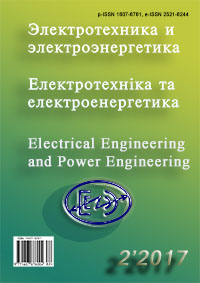ANALYTICAL CALCULATION OF THE BASIC ELECTROMAGNETIC LOSSES OF THE ENERGY OF THE FREQUENCY-REGULATED ASYNCHRONOUS ENGINE IN POSITIONING
DOI:
https://doi.org/10.15588/1607-6761-2017-2-3Keywords:
asynchronous motor, frequency regulation, electromagnetic energy losses, positioningAbstract
Purpose. Obtaining analytical dependencies for the calculation of the main electromagnetic energy losses of a frequency-controlled induction motor in positioning modes with small displacements for various types (linear, parabolic and quasi-optimal) of its velocity variation.
Methodology. Similarity methods, differential and integral calculus, analytical interpolation, mathematical analysis.
Findings. Analytical dependencies for calculation of current electromagnetic power losses and basic electromagnetic energy losses of a frequency-controlled asynchronous motor in the modes of positioning with small displacements for various types (linear, parabolic and quasi-optimal) of its velocity are obtained. A universal form of the analytical dependence for calculating the optimal acceleration and deceleration times for a frequency-controlled asynchronous motor for positioning with small displacements, corresponding to minimization of the main electromagnetic energy losses of this engine with the indicated positioning for various species (linear, parabolic and quasi-optimal), is obtained. A comparative quantitative assessment of the change is made: the optimum values of the main electromagnetic energy losses of the frequency-controlled asynchronous engine and the corresponding maximum speed and optimal acceleration and deceleration times, in the function of the set prescribed small displacements for the various engine speed trajectories under consideration.
Originality. For the first time, analytical dependencies for the calculation of the main electromagnetic energy losses of a frequency-controlled asynchronous motor are obtained for positioning with small displacements as a function of the set values of the movement of the motor shaft and the set values of its acceleration and deceleration times for the specified specified displacements. For the first time, dependences are obtained for a quantitative estimate of the minimum fundamental electromagnetic energy losses of an induction motor and the corresponding maximum speed and optimal acceleration and deceleration times in the function of the set given small displacements for a linear, parabolic and quasi-optimal trajectory of the engine speed during positioning.
Practical value. The calculated analytical dependencies obtained are intended for a quantitative estimation of the main electromagnetic energy losses of a frequency-controlled induction motor in the small-displacement mode. By determining, using the proposed analytical dependencies of the maximum speed values and the optimum acceleration and deceleration times of the frequency-controlled asynchronous motor, minimization of its main electromagnetic energy losses is achieved by positioning for linear, parabolic and quasi-optimal velocity trajectories.
References
Bulgakov, A. A. (1966). Chastotnoye upravleniye asinkhronnymi elektrodvigatelyami, Moscow, Nauka, 1966, 298.
Pivnyak, G. G., Volkov, A. V. (2006). Sovremennyye chastotno-reguliruyemyye asinkhronnyye elektroprivody s shirotnoimpulsnoy modulyatsiyey, Dnepropetrovsk: Natsionalnyy gornyy universitet, 470.
Polyakov, V. N. (2006). Ekstremal'noye upravleniye elektricheskimi dvigatelyami, Yekaterinburg: UGTU–UPI, 420.
Radin, V. I., Bruskin, D. E., Zorokhodich, A. Ye. (1988). Elektricheskiye mashiny: asinkhronnyye mashiny: Ucheb. dlya elektromekh. spets. Vuzov, Pod red. N.P. Kopylova, Moscow, Vyssh.shk., 328.
Sandler, A. S., Sarbatov, R. S. Avtomaticheskoye chastotnoye upravleniye asinkhronnymi dvigatelyami, Moscow, Energiya, 1974, 328.
Shreyner, R. T., Dmitrenko, Yu. A. (1982). Optimal'noye chastotnoye upravleniye asinkhronnymi elektroprivodami, Kishinev: Shtiintsa, 224.
Kovach, K. P., Rats, I. (1963). Perekhodnyye protsessy v mashinakh peremennogo toka, Per. s nem. yaz., Moscow: Gosenergoizdat, 744.
Merfi, Dzh. (1979). Tiristornoye upravleniye dvigatelyami peremennogo toka, Moscow, Energiya, 256.
Volkov, A. V., Kolesnikov, A. A. (2013). Energosberegayushcheye upravleniye skorost'yu chastotno-reguliruyemogo asinkhronnogo dvigatelya v puskotormoznykh rezhimakh, Elektrotekhnika, 5, 2 – 9.
Volkov, V. A. (2017). Elektrosberezheniye v chastotno-reguliruyemykh asinkhronnykh elektroprivodakh posredstvom optimizatsii vremen ikh razgona i tormozheniya, Vísnik Natsíonal'nogo tekhníchnogo uníversitetu «Kharkívs'kiy polítekhníchniy ínstitut», 27 (1249), 258-263.
Petrov, Yu. P. (1961). Optimal'noye upravleniye elektroprivodom, Moscow-Leningrad, Gosenergoizdat, 187.
Petrov, Yu. P. (1971). Optimal'noye upravleniye elektroprivodom s uchetom ogranicheniy po nagrevu, Leningrad, Energiya, 144.
Tolochko, V. I., Rozkaryaka, P. I., Chekavskiy, G. S. (2011). Optimizatsiya elektropotrebleniya pozitsionnogo elektroprivoda s vektornym upravleniyem asinkhronnym dvigatelem, Naukoví pratsí Donets'kogo natsíonal'nogo tekhníchnogo uníversitetu, 11 (186), 396 – 406.
Tikhovod, S. M. (2015). Usovershenstvovaniye iteratsionnykh metodov resheniya sistem nelineynykh uravneniy sostoyaniya magnitoeletricheskikh skhem zameshcheniya, Elektrotekhníka ta elektroenergetika, 1, 30 – 46. DOI: http://dx.doi.org/10.15588/ 1607-6761-2015-1-8
Tikhovod, S. M., Kornus, T. M., Patalakh, D. G. (2015). Metod uskorennogo chislennogo rascheta perekhodnykh protsessov v elektricheskikh tsepyakh na osnove approksimatsii resheniya algebraicheskimi polinomami, Elektrotekhníka ta elektroenergetika, 2, 48 – 54. DOI: http://dx.doi.org/10. 15588/1607-6761- 2015-2-7
Volkov, V. A. (2016). Optimalnoye i kvazioptimalnoye energosberegayushcheye upravleniye polozheniyem chastotnoreguliruyemogo asinkhronnogo dvigatelya, Elektrotekhníka ta elektroyenergetika, 1, 25 – 34. DOI: http://dx.doi.org/10.15588/1607-6761- 2016 -1-4.
Kalnitskiy, L. A., Dobrotin, D. A., Zheverzhev, V. F. (1976). Spetsialnyy kurs vysshey matematiki dlya vuzov, ucheb. Posobiye, Moscow, 389.
Venikov, V. A. (1976). Teoriya podobiya i modelirovaniya. Moscow, 479.
Downloads
Published
How to Cite
Issue
Section
License
Copyright (c) 2018 V. Volkov

This work is licensed under a Creative Commons Attribution 4.0 International License.
Creative Commons Licensing Notifications in the Copyright Notices
Authors who publish with this journal agree to the following terms:
Authors retain copyright and grant the journal right of first publication with the work simultaneously licensed under aCreative Commons Attribution License that allows others to share the work with an acknowledgement of the work's authorship and initial publication in this journal.
Authors are able to enter into separate, additional contractual arrangements for the non-exclusive distribution of the journal's published version of the work (e.g., post it to an institutional repository or publish it in a book), with an acknowledgement of its initial publication in this journal.
Authors are permitted and encouraged to post their work online (e.g., in institutional repositories or on their website) prior to and during the submission process, as it can lead to productive exchanges, as well as earlier and greater citation of published work.

